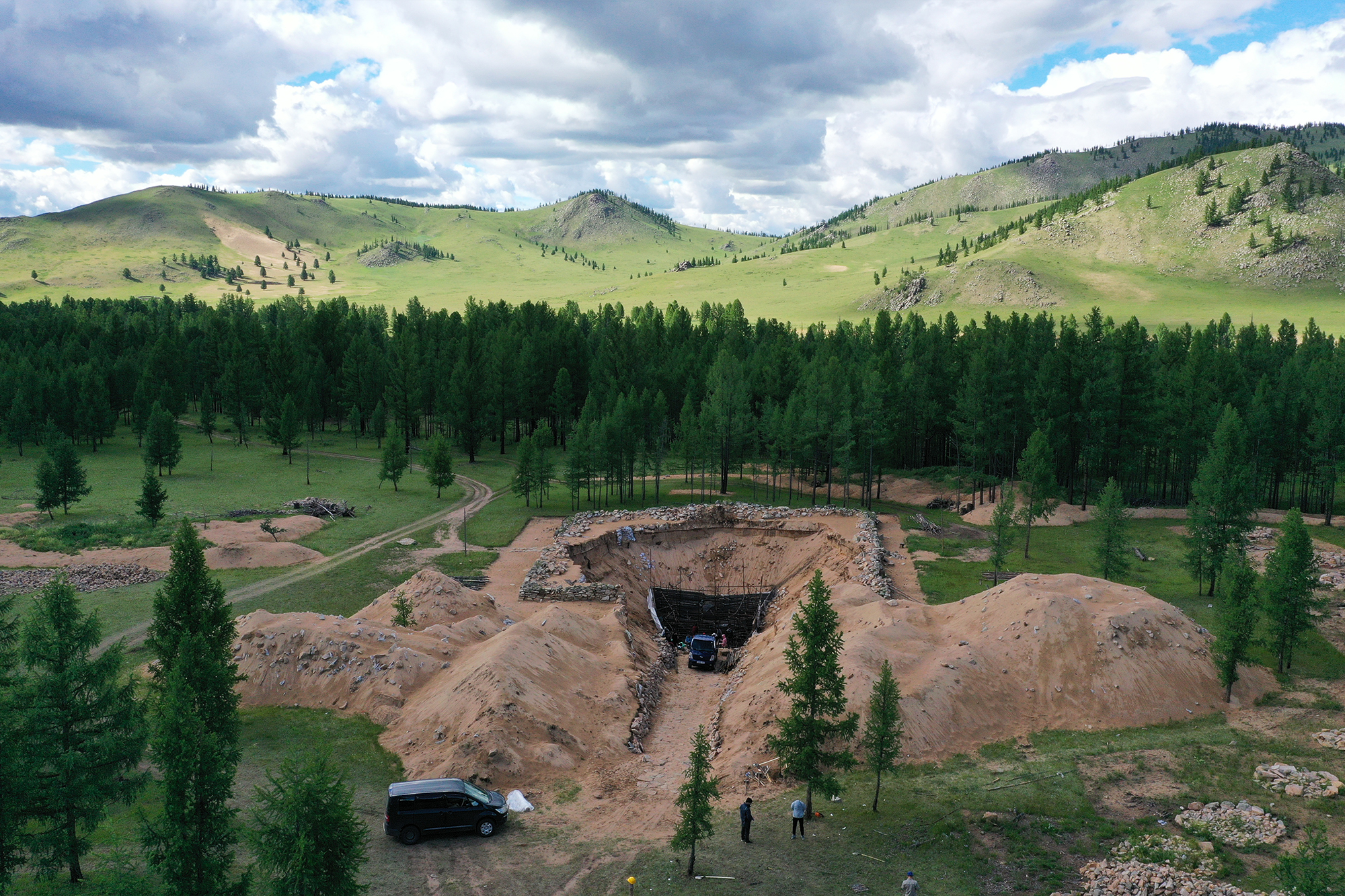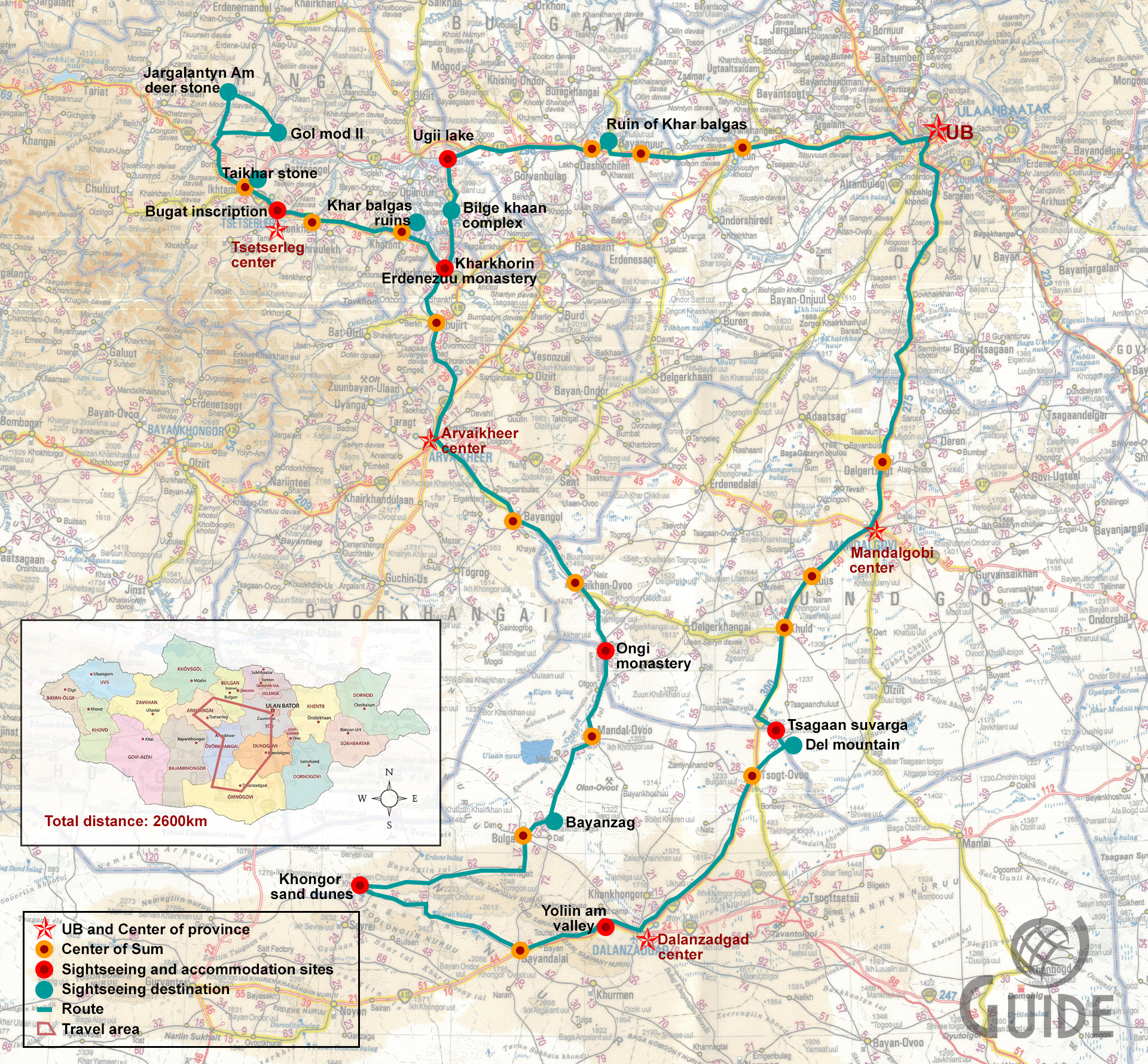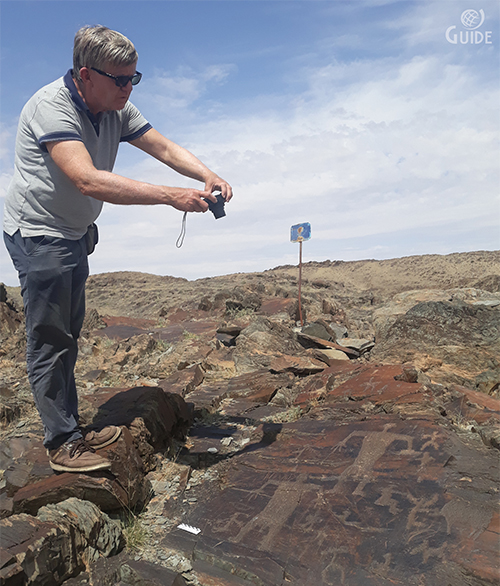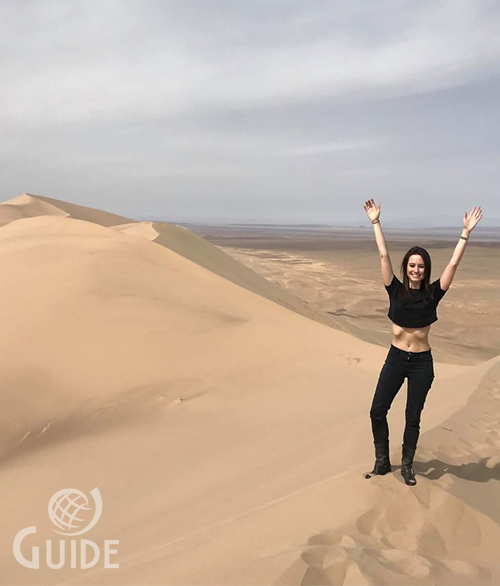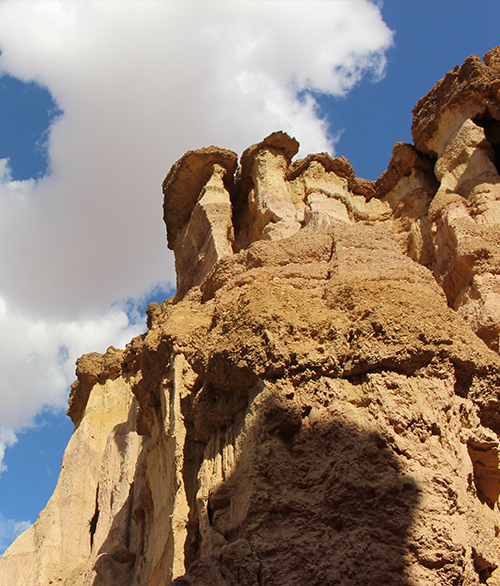Itinerary
DAY 1: Chinggis Khaan Airport - UB (55 km)
Our friendly professional team welcomes you at the Chinggis Khaan International Airport and transfers you to a hotel. Depending on your arrival schedule, you’re offered to take a city tour, including Chinggis Khaan Museum and Sukhbaatar square. The tour will be planned based on your arrival time.
Meal: Lunch, Dinner
Accommodation: Hotel
DAY 2: UB – Mandalgovi – Tsgaan suvarga (450 km)
Early morning, departing from Ulaanbaatar, we head to the south to Tsagaan Suvarga which is one of the unique formations of the Gobi Desert. We drive from Ulaanbaatar 420 km on a paved road and 30 km offroad. On the way, travelers take lunch at Dundgovi province’s center. Once the ocean bed where the visitors find marine fossils and clamshells, the Tsagaan Suvarga is a 6000m long colorful limestone formation. The spectacular nature of Tsagaan Suvarga will provide you with extraordinary natural scenery during the sunset and sunrise.
Meal: Breakfast, Lunch, Dinner
Accommodation: Tourist camp
DAY 3: Del Uul – Dalanzadgad - Yoliin am (220 km)
We depart from the Tsagaan Suvarga early morning to Del Uul mountain. The mountain Del Uul is a wonderful historical sight that preserves the agricultural and spiritual development of humans and ancient nomads. We will travel 20 km through the mountain Del Uul Valley and see a major representation of rock art of the Neolithic and Bronze Age. Then, we arrive at Dalanzadgad city (Umnugovi province’s center) and take lunch there. We continue our trip to Yoliin am (Bearded vulture valley). It is a high rocky gorge about 2800 meters above sea level and is named after the Yol bird (Bearded vulture). Through the corridor of its rock walls, it has a small stream. In the valley, some places have 200-meter-high straight rock walls which have breathtaking scenery. Crossing back through the gorge, we travel through Dungenee canyon and arrive at a tourist camp.
Meal: Breakfast, Lunch, Dinner
Accommodation: Tourist camp
DAY 4: Khongor Sand dunes (180 km)
After early breakfast, we drive to Khongor Sand dunes. The Khongor sand dunes are the third biggest dunes in Mongolia and one of the major tourist destinations in Mongolia. From the Sevrey mountain, south of the sand dunes, there streams a beautiful river called Khongor river which flows below the sand dunes and makes gorgeously green grass on the north side of the sand dunes. Green grass covering land behind yellow sand under blue sky adds perfect harmony to nature. Through the edge of the sand dunes, camel herder families live throughout summertime and the river is the main water source for their livestock. Before sunset, we reach Khongor sand dunes riding a camel. You will climb up to the Duut mankhan (Singing dunes which is the highest of the sand dunes) and experience inspiring views of the surrounding area and see spectacular Gobi Desert sunset.
Meal: Breakfast, Lunch, Dinner
Accommodation: Tourist camp
DAY 5: Bayanzag – Ongi Monastery (310 km)
Taking lunch around sunrise, we depart to Bayanzag. Bayanzag is an important place that made Mongolia famous in the field of world paleontology. Today well known as “flaming cliffs” due to their colors ochre and red, Bayanzag was proved as a place where dinosaurs hatched their eggs and laid their eggs like birds to mature. Also, in the Bayanzag, researchers found stone tools from the ancient people’s habitation landmarks with similar structures found in the American Alaska Peninsula. After lunch, we depart Umnugobi province to Ongi Monastery in the Ongi steppe of Dundgobi province. We visit the ruins of a large Buddhist monastery existed 350 years ago. The ruins of the monastery can be seen throughout full hillside of the mountain. The Ongi river flows in front of it. Since there are rare water resources in the Gobi region of Mongolia, the Ongi River is an important treasure that sustains the life of people in the Gobi Desert. After seeing the ruins of the monastery, learn more about the history of Mongolian Buddhism and take a well-rest at the tourist camp.
Meal: Breakfast, Lunch, Dinner
Accommodation: Tourist camp
DAY 6: Ongi Monastery – Kharkhorin (260 km)
After breakfast, we head to Arvaikheer city. We visit “The Great horse temple of the Mongolian people” and then we move to Kharkhorin. The history of Mongolians cannot be imagined without horses, and everything related to horses is worshipped as a symbol of spirit. The horse temple complex was established in 2007, and there are statues of famous jockeys from every region of Mongolia. This area is not only a place worshiped by jockeys but also a place where the famous fast stallion named "Aravgar Heer" was born and raised. The story tells that in 1709, “Aravgar Heer” stallion won in the Great Danshig Festival (The biggest of the Naadam festivals) among more than 1000 jockeys’ races. Next, we will arrive in Kharkhorin and take lunch at a tourist camp. Later, we visit the Karakorum Museum, which tells us the story of how Karakorum flourished when it was the capital of the Mongol Empire. Also, we see the turtle stone statue, which is an important monument of Karakorum city. An inscription was found on the back of the turtle stone where carved the order of King Munkh Khan to build a Buddhist temple the size of the current 5-story building in Karakorum.
Meal: Breakfast, Lunch, Dinner
Accommodation: Tourist camp
DAY 7: Khar Balgas ruins – Tsetserleg city - Taikhar stone (190 km)
We start the day with a tour of the Gurvan Zuu temple of Erdene Zuu monastery. In this 440-year-old artistic building, portraits of gods, sculptures, religious items, and dozens of other artworks registered in Mongolia's precious heritage are displayed. Even though it is a Buddhist temple, it works with the status of a museum. After lunch, we drive to Khar Balgas ruins (Black City ruins), which was the capital of Uyghur Khaganate in the 7th - 8th centuries. However much of the city walls have collapsed at present, and the remains are still 12-14 meters high. Khar Balgas ruins were registered as a world cultural heritage by UNESCO in 1996 under the category of "Wonderful World Heritage". Then, arriving in Tsetserleg city, you will see the Arkhangai Province Museum and the Bugat inscription. At the top of the inscription, which was created 1440 years ago, there is a figure of a "wolf nursing a child". At the bottom of it, on three sides, there are Brahmi or ancient Mongolian words and Turkic scripts written. Arkhangai Province Museum operates in a Buddhist temple built in 1631, and the building is one of the important historical and cultural heritages. Then, we drive to the tourist camp next to the Taikhar Stone on the banks of the Tamir River and explore the uniqueness of the Taikhar Stone. It is an 18-meter-high stone with Mongolian, Manchu, Chinese, and Tibetan inscriptions.
Meal: Breakfast, Lunch, Dinner
Accommodation: Tourist camp
DAY 8: Gol Mod II site – Jargalantyn am complex – Tsetserleg (260 km)
Early morning, we continue our trip to the funeral site of the Hunnu Empire, Gol Mod II site. It is a site with about 570 graves dating back to 80-100 AD, and the researchers found that one king's burial was accompanied by 25-30 people's burials from its servants. As researchers found, the age of them was a 1.6-year-old child to a 39-year-old man. A total of 17-18 chariot parts were found in the graves and 14 of them were found to be fully assembled. As well as, thousands of artifacts have been found to prove that the equipment of horses used in carriages was decorated entirely with gold and silver. Then, we will go to Mongolia's largest deer stone statue complex dating back to the YI-Y century BC. It is called Jargalantyn Am deer stone statues, and there are 28 deer stone statues with a height of 0.4-4 meters. Also, approximately 1400 sacrificial structures were found around it. Then we return to Tsetserleg city and spend a restful evening at the hotel.
Meal: Breakfast, Lunch, Dinner
Accommodation: Hotel
DAY 9: Bilge Khan complex – Ugii Lake (220 km)
In the morning, we drive to the Bilge Khan complex through Kharkhorin. On the way, you will see Shiveet Tolgoi, a site from the Turkic period. An archeological excavation found a 2-meter-high and 4-meter-thick stone wall in an area of 30x30 meters. It is believed to be a guard tower where the soldiers of the last Turkic king Bilge Khan were stationed. After having lunch at the tourist camp, we will visit the nearby ruins of sacrificial temples dedicated to the memory of Bilge Khan, the last king of Turks, and his brother, General Kul Tigin. Based on the artifacts and valuable historical heritage found in the excavations, an important historical museum was established there. The solid gold crown of Bilge Khan is considered one of the wonderful artifacts from the excavation. Also, the history of the last days of the Turkish Empire is told by engraving with more than 10,000 runic letters on two steles, each of them is 3-meter-high. These important monuments have been registered on the UNESCO World Heritage List. Then, we arrive at the Ugii lake’s Information center. The lake covers 25 sq. km of an area with a length of 7 km and width of 5 km and 15m at its deepest. As researchers found out, there are 14 species of fish, 27 species of floating plants, and 48 species of floating animals which included the Arctic Ocean ecosystem. Therefore, with its distinction, some 150 species of water birds gather along the lake.
Meal: Breakfast, Lunch, Dinner
Accommodation: Tourist camp
DAY 10: Khar Bukh Balgas – Ulaanbaatar (340 km)
We drive early morning to Khar Bukh Balgas, the fortress, inhabited by the Kitans in the 10th-12th century. Nowadays, the ruins of the fortress covered an area of 500 square meters and are built with big stone cuts. The stones of the fortress were included volcanic basalt, grindstone, and sedimentary rocks that beautifully stacked on top of each other. We arrive at the Mongolian Nomadic tourist camp and take lunch there. There you will visit the herder nomadic family and get to know more about their lifestyle, greeting culture, food, and clothing tradition, and simple furniture and appliances of Ger which suit ordinary nomadic life. You can also ride a yak cart, horse, or camel, and ride a yak to take a short tour around the camp. This nomadic tourist camp has attracted a lot of interest from tourists in recent years. Then we drive to UB city. You will go to the shopping centers and souvenir shops, and you may shop for cashmere and souvenirs. After dinner, you will take a good rest at the hotel.
Meal: Breakfast, Lunch, Dinner
Accommodation: Hotel
DAY 11: UB - Chinggis Khaan Airport (55 km)
We transfer you to the airport according to your departure schedule. You take a return flight to your respective country from the Chinggis Khaan International Airport.
Meal: Breakfast


